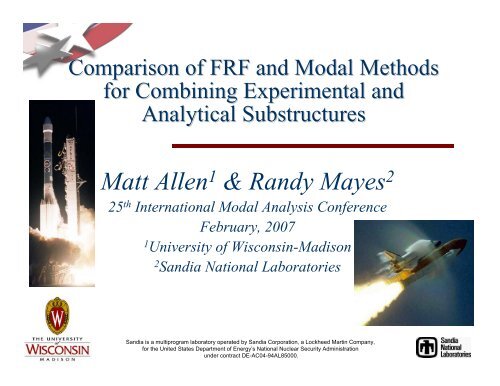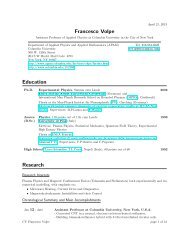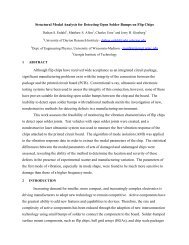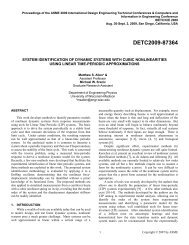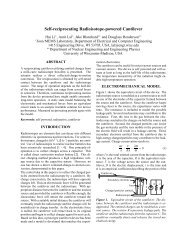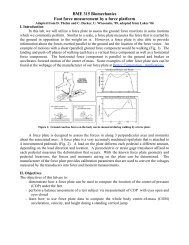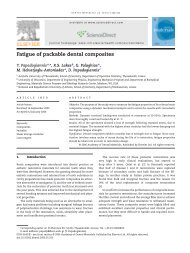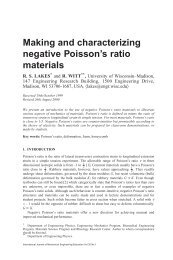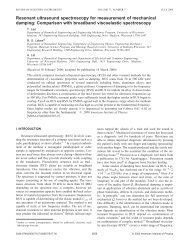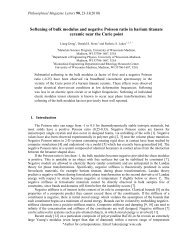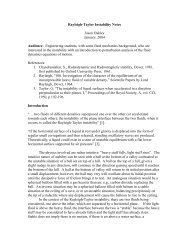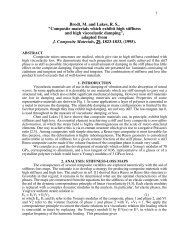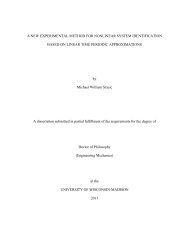Matt Allen & Randy Mayes
Matt Allen & Randy Mayes
Matt Allen & Randy Mayes
You also want an ePaper? Increase the reach of your titles
YUMPU automatically turns print PDFs into web optimized ePapers that Google loves.
Comparison of FRF and Modal Methods<br />
for Combining Experimental and<br />
Analytical Substructures<br />
<strong>Matt</strong> <strong>Allen</strong> 1 & <strong>Randy</strong> <strong>Mayes</strong> 2<br />
25 th International Modal Analysis Conference<br />
February, 2007<br />
1 University of Wisconsin-Madison<br />
2 Sandia National Laboratories<br />
Sandia is a multiprogram laboratory operated by Sandia Corporation, a Lockheed Martin Company,<br />
for the United States Department of Energy’s National Nuclear Security Administration<br />
under contract DE-AC04-94AL85000.
Outline<br />
Motivation<br />
Modal Coupling vs. FRF Coupling<br />
Component Mode Synthesis Theory<br />
Methods for connecting subsystems<br />
Connection Point Method (CPT)<br />
Modal Constraint for Fixture and Subsystem (MCFS)<br />
Experimental Results<br />
Rigid Fixture Model with CPT constraint<br />
Elastic Fixture Model with CPT constraint<br />
Elastic Fixture with MCFS constraint<br />
Conclusions<br />
2
Subcomponents are often<br />
designed by a number of<br />
independent groups that do<br />
not have the information or<br />
the resources to model the<br />
macro system.<br />
In other applications some<br />
particular components may<br />
be too difficult to model<br />
analytically with the<br />
required precision.<br />
Motivation<br />
Analytical<br />
Model<br />
+<br />
Experimental<br />
Model<br />
3
Modal vs. FRF Coupling<br />
Two distinct approaches to substructure coupling exist:<br />
Component Mode Synthesis or<br />
Modal Coupling:<br />
Modal models for substructures<br />
combined to find an approximate<br />
modal model for the total system.<br />
Requires modal parameter<br />
estimation to reduce measurements<br />
to a modal system model.<br />
Measurements must be sufficient to<br />
obtain reasonably accurate<br />
estimates of each important modal<br />
frequency and mode shape at the<br />
connection points.<br />
Results can sometimes be<br />
understood by appealing to wellestablished<br />
Ritz Theory.<br />
Disadvantage: It is not always easy<br />
to identify an adequate modal model<br />
from experimental measurements.<br />
FRF Based Admittance or<br />
Impedance Coupling:<br />
Response measurements (FRF<br />
matrices) for substructures<br />
combined to find FRFs for total<br />
system.<br />
Can be performed on raw FRFs<br />
(even if modal parameter estimation<br />
is not feasible.)<br />
However, all connection point<br />
FRFs must be measured if MPE is<br />
not employed.<br />
6*N c × 6*N c set of FRFs!<br />
Numerical ill-conditioning may<br />
present a formidable challenge.<br />
Modal parameter estimation is very<br />
desirable to reduce measurement<br />
errors for lightly damped systems.<br />
[Imregun, Robb, Ewins IMAC-1987]<br />
4
Component Mode Synthesis<br />
Given a set of modal parameters, one has a set of<br />
equations of motion (EOM) for a substructure:<br />
{y} is a vector of physical coordinates<br />
{η} are modal coordinates<br />
[ω r 2 ] is a diagonal matrix of natural frequencies squared<br />
[Φ] is a matrix of mass-normalized mode vectors.<br />
Consider two independent structures A and B:<br />
A yc + yc B<br />
Their EOM are….<br />
5
Component Mode Synthesis (2)<br />
y c<br />
Connect them by enforcing linear constraints:<br />
+<br />
A B<br />
All DOF can be expressed in terms of an unconstrained set of<br />
generalized coordinates as<br />
The equations of motion in unconstrained coordinates are then:<br />
y c<br />
Paper includes a method<br />
that chooses constrained<br />
DOF so that this matrix is<br />
always invertible if such a<br />
choice exists.<br />
6
Component Mode Synthesis (3)<br />
One can now find the modes of the combined<br />
system, construct FRFs, etc… using these EOM.<br />
The mode shapes of the combined system are<br />
found in the physical coordinates of A and B.<br />
The combined system mode shapes are linear<br />
combinations of the mode shapes of the<br />
subcomponents A and B.<br />
One must assure that enough modes of both A and B<br />
are present so that these are a good approximation for<br />
the true modes of the combined system.<br />
7
Simulation Example<br />
Case 1: Free-Free (FF) modes – modal parameters of<br />
each FF beam used to predict combined system<br />
response:<br />
D<br />
yc + yc B<br />
Case 2: Mass-Loaded (ML) modes – parameters of<br />
modes with fixture on B.<br />
D<br />
y c<br />
Cases simulated by joining only the modes of B below<br />
10 kHz to the FE model for D<br />
The result is compared to the full FE solution for E.<br />
+<br />
y c<br />
B<br />
-<br />
8
Axial Displacement<br />
15<br />
10<br />
5<br />
0<br />
-5<br />
-10<br />
Simulation Example: Axial Results<br />
Natural Frequencies (Hz)<br />
Mode E-FEA E-FF E-ML Error (E-FF) Error (E-ML)<br />
(free-free) (mass-loaded) (free-free) (mass-loaded)<br />
1 0.0 0.0 0.0 0.0% 0.0%<br />
2 2824.8 2919.4 2829.7 3.3% 0.2%<br />
3 5649.1 5860.6 5651.3 3.7% 0.0%<br />
4 8472.5 8472.5 8678.5 0.0% 2.4%<br />
5 11294.3 11758.9 12171.5 4.1% 7.8%<br />
Mode Shapes - 3 ft Beam - (-) True FE (-.) FF (o:) ML<br />
-15<br />
0 4 8 12 16 20 24 28 32 36<br />
Position (in)<br />
D B<br />
E<br />
1<br />
2<br />
3<br />
Both approaches predict<br />
the axial modes in the<br />
frequency band with less<br />
than 5% error.<br />
The mass loaded modes<br />
predict most of the<br />
natural frequencies and<br />
mode shapes more<br />
accurately.<br />
9
+<br />
Test System<br />
A<br />
D yc y B - A<br />
=<br />
c<br />
E<br />
Objective: Join an experimental model of beam B to an<br />
analytical model for beam D at point y c .<br />
Measurements are taken on system C consisting of beam B<br />
with fixture A attached.<br />
Analytical model (Euler-Bernoulli) for fixture A removed<br />
from system C resulting in an experimental model for beam B.<br />
Analytical model for fixture A<br />
Beam B is then combined with an analytical model (tunned<br />
Euler-Bernoulli) for beam D to find the combined system<br />
Beam E.<br />
C<br />
10
A<br />
Experimental Procedure<br />
Careful tests used to estimate the modal parameters of the C<br />
system at a number of points on fixture A.<br />
11
Connection Methods – CPT and MCFS<br />
One cannot measure the response at the connection point directly,<br />
so it must be estimated from other measurements.<br />
CPT Method: Connection point responses for the experimental system are<br />
estimated using a modal filter and constrained to the analytical fixture A<br />
and beam D:<br />
{ y }<br />
⎧ ⎫ ⎡ ⎤<br />
⎪ ⎪ ⎣<br />
⎡Φ⎦ ⎤<br />
⎨ ⎬≈⎢ ⎥ → = ⎡Φ ⎤⎡Φ ⎤<br />
{ C}<br />
A<br />
⎣ ⎦⎣ ⎦<br />
⎪ y ⎪ ⎢⎡Φ⎤⎥ ⎣⎣ c ⎦⎦<br />
C A<br />
m m<br />
C C A A<br />
†<br />
C<br />
⎩ c ⎭<br />
{ η } { y } { }<br />
c m y<br />
c m<br />
MCFS Method: Constrain the modal DOF of the Fixture model to their<br />
approximation on C: (MCFS stands for Modal Constraint for Fixture and<br />
Subsystem)<br />
†<br />
⎫<br />
⎣ ⎦ ⎪<br />
⎬ → =<br />
{ A} A { A<br />
η = ⎡Φ ⎤ }<br />
m y<br />
†<br />
⎡<br />
⎣<br />
⎤<br />
⎦<br />
⎪<br />
m ⎭<br />
{ C} A { C<br />
η = Φ }<br />
m y<br />
{ η } { η }<br />
m A C<br />
12
Connection Methods – Rationalization<br />
CMS can be very sensitive to errors when<br />
removing a substructure from a system.<br />
In the problem considered here the fixture<br />
response is dominated by (4) modes.<br />
Requiring equal 2D motion at the<br />
connection point enforces only (3)<br />
constraints.<br />
4 DOF*2 Systems –3 Constraints = 5 Remaning DOF<br />
Two elastic modes remain in the system. One<br />
would hope that these have no effect on the<br />
response.<br />
It might be preferable to remove these extra<br />
modes by adding constraints rather than simply<br />
hope that the fixture model is accurate enough<br />
so that they cancel.<br />
+<br />
+<br />
13<br />
_<br />
_
Cases Considered<br />
Case 1: CPT: Models for A, C and D joined at<br />
the connection point.<br />
Case 1a: Rigid Fixture Model<br />
Case 1b: Elastic Fixture Model<br />
Case 2: MCFS: Models for A and C joined using<br />
MCFS method.<br />
Elastic Fixture Model<br />
+<br />
D yc yc B<br />
yc +<br />
MCFS<br />
D yc B<br />
yc -<br />
-<br />
14
Phase [deg]<br />
FRF magnitude []<br />
0<br />
-180<br />
-360<br />
10 5<br />
10 4<br />
10 3<br />
Case 1a: Rigid A, CPT<br />
Lateral FRFs<br />
Analytical<br />
CMS<br />
Admit<br />
0 1000 2000 3000 4000 5000 6000<br />
Frequency (Hz)<br />
Excellent results<br />
obtained in the<br />
lateral direction<br />
(Bending Modes).<br />
Both the CMS and<br />
FRF based<br />
Admittance<br />
procedures agree<br />
very well with the<br />
analytical model.<br />
The CMS result is<br />
slightly<br />
contaminated by<br />
the axial modes at<br />
2400 and 5200 Hz.<br />
15
Phase [deg]<br />
FRF magnitude []<br />
0<br />
-180<br />
-360<br />
10 6<br />
10 5<br />
10 4<br />
10 3<br />
10 2<br />
10 1<br />
Case 1a: Rigid A, CPT<br />
Axial FRFs<br />
Analytical<br />
CMS<br />
Admit<br />
0 1000 2000 3000 4000 5000 6000<br />
Frequency (Hz)<br />
Admittance and CMS<br />
both under-predict the<br />
natural frequencies of<br />
the axial modes by<br />
10% or more.<br />
These errors are<br />
larger than one<br />
would expect due to<br />
modal truncation<br />
alone.<br />
Rigid fixture model<br />
is not adequate.<br />
Both also over-predict<br />
the axial motion in the<br />
bending modes<br />
resulting in<br />
contamination at the<br />
bending natural<br />
frequencies.<br />
Possibly due to<br />
small curve fitting<br />
errors or cross axis<br />
sensitivity.<br />
16
Phase [deg]<br />
FRF magnitude []<br />
0<br />
-180<br />
-360<br />
10 5<br />
10 4<br />
10 3<br />
10 2<br />
10 1<br />
Analytical<br />
CMS<br />
Admit<br />
Case 1b: Flexible A, CPT<br />
Axial FRFs<br />
0 1000 2000 3000<br />
Frequency (Hz)<br />
4000 5000 6000<br />
Both Admittance<br />
and CMS<br />
accurately predict<br />
the first axial<br />
frequency with the<br />
flexible fixture<br />
model.<br />
Both methods<br />
more severely<br />
under-predict the<br />
second axial<br />
mode.<br />
Both predict a<br />
spurious zero near<br />
5500 Hz.<br />
The Lateral FRFs<br />
were similar to<br />
those shown<br />
previously.<br />
17
Phase [deg]<br />
FRF magnitude []<br />
0<br />
-180<br />
-360<br />
10 5<br />
10 4<br />
10 3<br />
10 2<br />
10 1<br />
Case 2: Flexible A, MCFS Method<br />
Axial FRFs<br />
Analytical<br />
CMS<br />
0 1000 2000 3000 4000 5000 6000<br />
Frequency (Hz)<br />
The CMS method<br />
predicts the axial<br />
FRF very<br />
accurately when<br />
the Modal<br />
Constraint for<br />
Fixture and<br />
Subsystem<br />
(MCFS) is used.<br />
18
The E system models obtained were<br />
not completely physical.<br />
Some of the E system models had<br />
complex natural frequencies<br />
The E system mass matrix was not<br />
always positive definite.<br />
This is to be expected since an<br />
approximation to the stiffness of the<br />
fixture has been removed.<br />
When combining structures, the<br />
spurious modes all appear at high<br />
frequencies, yet they can appear at<br />
lower frequencies when removing a<br />
substructure.<br />
In these cases, the spurious natural<br />
frequencies are always near the<br />
extremes of the frequency band.<br />
Admittance results also show nonphysicality<br />
(negative eigenvalues of<br />
drive point FRFs at some<br />
frequencies).<br />
Physically Realizable Models<br />
Case 1a<br />
Rigid Fixture,<br />
Con. Pt.<br />
Case 1b<br />
Flexible<br />
Fixture, Con.<br />
Pt.<br />
Case 2<br />
Flexible<br />
Fixture, MCFS<br />
Complex f n<br />
(Hz)<br />
0 + i*8.93e-5<br />
0 + i*54100<br />
0 + i*1.36e-4<br />
8951 – i*2450<br />
8951 + i*2450<br />
0 + i*2.28e-4<br />
13050 – i*4285<br />
13050 + i*4285<br />
19<br />
eig(M) <<br />
0<br />
-0.011<br />
-1<br />
-0.086
It could be worse!<br />
Case 1a<br />
Rigid Fixture,<br />
Con. Pt.<br />
Case 1b<br />
Flexible<br />
Fixture, Con.<br />
Pt.<br />
Case 2<br />
Flexible<br />
Fixture, MCFS<br />
Complex f n<br />
(Hz)<br />
0 + i*8.93e-5<br />
0 + i*54100<br />
0 + i*1.36e-4<br />
8951 – i*2450<br />
8951 + i*2450<br />
0 + i*2.28e-4<br />
13050 – i*4285<br />
13050 + i*4285<br />
20<br />
eig(M) <<br />
0<br />
-0.011<br />
-1<br />
-0.086
Lateral (bending direction)<br />
Conclusions<br />
Both Component Mode Synthesis (CMS) and FRF based<br />
Substructuring (Admittance) can be used to accurately predict<br />
the lateral modes of this Experimental-Analytical system.<br />
Axial direction:<br />
It was necessary to account for the elasticity of the fixture to<br />
obtain accurate estimates of the axial modes.<br />
When doing so, the Modal Constraint for Fixture and<br />
Substructure (MCFS) method improved the accuracy of the<br />
predictions when compared to the connection point method<br />
(CPT).<br />
MCFS allows one a new level of freedom when designing test<br />
fixtures for these types of analyses.<br />
It would be helpful to have a method of removing test fixtures<br />
that assures that a physically meaningful model is obtained.<br />
21


